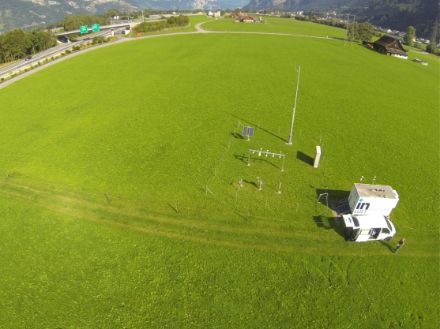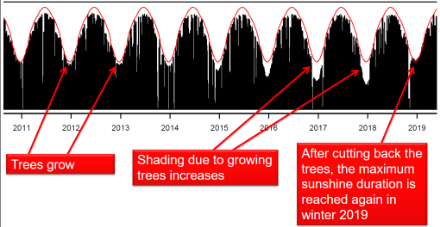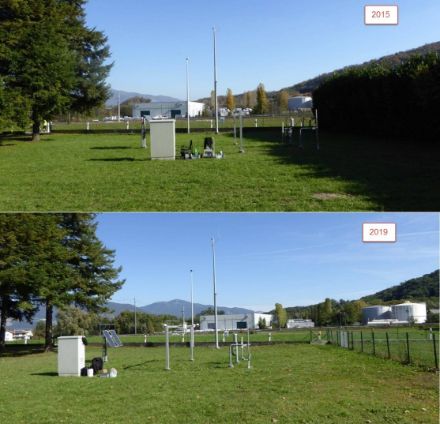Service Navigation
Search
As part of the certification procedure, around 100 quality criteria are checked.These are based on the so-called «WMO Guide No. 8», dem Guide to Instruments and Methods of Observation. The principles, which are formulated to create standardisation, have been adjusted to take account of Switzerland's specific characteristics, with a particular focus on the areas of climatology and meteorology. For this reason, the procedure is not suitable for other areas of application such as agricultural meteorology or travel weather for road users; other local criteria apply in these areas.
What is checked during the certification process
Roughly speaking, the criteria can be divided into five areas:
- The measurement and transmission interval of the monitoring station: Does a station take measurements and transmit data every ten minutes? Or are the data only transmitted on an hourly or even daily basis?
- Details on the measurement location: Do the location and measurement height correspond to the recommendations of the WMO for the respective parameters? Has the instrument been set up correctly?
- Assessment of the individual measurement instruments: Does the instrument deliver the degree of accuracy required by the WMO? Is it correctly ventilated and/or heated? Does it also work in snow and hail?
- Calibration, maintenance and upkeep: How often is calibration performed in the laboratory and/or maintenance on site? Does the station have a supervisor who performs regular checks? Are parallel measurements taken and/or are automatic data checks conducted in order to ensure faulty instruments are quickly identified?
- Data analysis: The data analysis is performed by a partner after one year of data deliveries; this primarily examines the completeness of the data and speed of data transmission.
Assessment of monitoring stations
Based on the examination of a station, the measurement instruments are assigned one of the following categories:
- Compliant: An instrument fulfils all criteria.
- Mostly compliant: An instrument fulfils most of the criteria, or some criteria are slightly violated. Acknowledgment of the limitations when using the measurement data is recommended.
- Non-compliant: The measurements do not meet several of the criteria. The data may be used if the limitations of the data are borne in mind.
- Special location: Location does not meet certain criteria. The measurement data are nevertheless representative of the location/surroundings in spite of non-compliant set-up (e.g. tower locations).

Introduction of certification and the certification procedure
The integration of partner stations within the MeteoSwiss data warehouse served as the impetus for the development of an independent certification procedure. This step made it essential to introduce an approval process for automatic monitoring stations. Only in this way can the relevant criteria be assessed objectively. This is a pre-requisite for being able to compare the results taken from different stations.
The quality assurance procedure developed by MeteoSwiss is performed by the Federal Office of Metrology (METAS). The independent body certified SwissMetNet and 20 partner stations for the first time in 2013. In doing so, a great deal of useful information was gleaned and subsequently incorporated into the certification procedure. Since 2014, the certification has been a fixed part of the operation of numerous monitoring stations integrated within the MeteoSwiss data warehouse. It is planned to check each station every five years. The results are discussed internally with the operations teams and with the relevant partners; measures aimed at improving the measurement quality are devised and implemented as quickly as possible. The objective is not always to achieve the highest quality level, but rather the level of quality appropriate for the area of application.
Example of the use of certification in day-to-day operations
Since the introduction of this inspection, it has been possible for us, in cases of problematical discussions with landowners, to clearly show the need for specific action and concrete measures, such as being able to bushes to be cut back. This leads to an improvement in the quality of the measurements, as the Stabio example superbly demonstrates.
The graph below shows the daily sunshine hours at the Stabio station between 2011 and 2019. The red line illustrates the maximum possible sunshine hours for that location. It can be seen from the graph how the recorded sunshine hours decrease every winter after about winter 2012. An inspection in 2017 revealed that the meadow in the neighbouring plot had become increasingly overgrown, and the trees were throwing a shadow on the instruments.

A conversation with the landowner in 2018 led to the trees to the south of the station being cut back, and the original meadow being exposed once again. This can be seen from the photograph below. We can also see, however, that there are still trees to the north of the station, which means that the maximum sunshine hours cannot be measured in summer (see above graph). These trees are protected and cannot be felled. The search for a suitable location for a station is and always will be a challenge in densely populated Switzerland!
